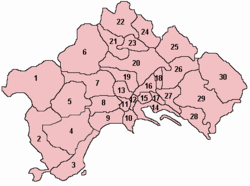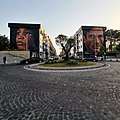Scampia
Scampia (Italian: [skamˈpiːa], Neapolitan: [ʃkamˈbiːə]) is a modern suburb in the far north of Naples, whose population is about 80,000. To its south are the suburbs of Piscinola-Marianella, Miano and Secondigliano. It was built during the second half of the twentieth century.

History
Scampia was built as a bedroom suburb in the 1960s. The area was mostly developed in the 1970s and 1980s with huge, high-rise residential blocks, in particular after the 1980 earthquake with construction of housing in the area called "167" for displaced Neapolitans.[1] Huge apartment complexes, wide boulevards and a massive park were built, without commercial districts or entertainment venues. Many people, however, were not placed in Scampia because of the problems caused by the earthquake. They occupied house in different buildings of the neighbourhood, in particular many houses in the "Vele". That was especially due to the Camorra crime syndicate, that took control of the "Vele" and turned them into their own space in which drug could be sold or hidden from the police. Large metal gates on some of the walkways and stairs in the blocks of flats have been put there, not by the council, but by the Camorra itself, so they can be locked by drug pushers as they flee the police.[2][3] With over 50% unemployment, the area had in fact a very high crime rate, with heroin and cocaine sold, and used openly, in the streets.[4]
Scampia was also the territory of the Di Lauro clan, which controlled the drug trade and most other illegal activities in the area. In 2004 a bloody gang war erupted in the area, the so-called Scampia feud, between the Di Lauro family and a breakaway faction, the "secessionists".[5][6]
The death of an innocent woman, Gelsomina Verde, caused widespread public revulsion and led to a major crackdown by the authorities. She was abducted, brutally beaten in an effort to get her to disclose the whereabouts of a gang member involved in the feud, and finally shot in the neck. Her body was stuffed in a car that was set on fire.[7]
Vele di Scampia
The Vele di Scampia (English: Sails of Scampia) is a large urban housing project built between 1962 and 1975 in the Scampia neighbourhood. It was named for the triangular shaped buildings, reminiscent of a sail, as they are wide at the base and narrowing as they rise. They are similar to Marina Baie des Anges in Villeneuve-Loubet, France.
Built as a result of Law 167, which was passed in 1962, the Sails of Scampia were designed by Franz Di Salvo.[8][9] They were part of a project which also included development of the city of Naples to the east, in Ponticelli. They best represent Di Salvo's style of architectural design. Di Salvo first designed low-cost housing in 1945. He worked in collaboration with other architects, to design the District of Cesare Battisti Poggioreale, which represented the paradigm of a "new way of thinking" about social housing.
After years of continuous design experiments, the task of establishing a large apartment complex in Scampia was entrusted to the Cassa del Mezzogiorno. The design followed the housing unit principles articulated by Le Corbusier for the design of public housing. He was influenced by the trestle structures proposed by Kenzō Tange.[10] Di Salvo proposed a plan for the district which was based on two building types: a "tower" and "tent". The tent type provides the dominant impression of sails. The buildings were designed following the idea of existenzminimum (subsistence dwelling): the dwellings themselves were deliberately minimal, with many shared exterior spaces where life would take place. This was done with the specific aim of reconstructing the spirit of Naples's alleys and courtyards, crowded but congenial, in an apartment building. This philosophy additionally reduced construction costs;[11] and construction was skimped as funds were stolen, and the works were not finished.[12]
Decline
Originally, the complex consisted of seven massive apartment blocks, and housed from 40,000 to 70,000 people, although a real headcount was never conducted. Three of the seven blocks have been demolished, but some 40,000 people still live in the damaged structures.[10]
The idea behind the project was to provide a huge public housing project, where hundreds of families could socialize and create a community.[11] The design included a public transportation rail station, and a large park area between the two buildings. The planners wanted to create a small city model with large parks, playing fields, and other facilities.
However, various causes have led to what is now regarded as a ghetto. Right after the earthquake in 1980, many families in the area were left homeless. Many of these families without shelter started to occupy the apartments illegally. Tolerated and ignored by the government, more people started to occupy the buildings including criminals.[9] Things were made worse by the total lack of police presence, resulting in drug trafficking, illegal street racing, gangs, and fencing operations. Roberto Saviano wrote the book Gomorrah about organised criminality by the Camorra (the Neapolitan mafia)—with the Vele playing a big part—and discussed the Vele and their decline and criminality extensively in a long article about the demolition of the last of the sails in 2020.[11]
The first police station for the area was established in 1987, fifteen years after people began occupying the apartments.
Demolition
Following continuous protest by the residents who felt that their extensive problems could not be fixed, the intention to demolition of the complex was announced in 2016.[13] In 2019 residents began moving into new apartments built nearby, the apartments empty and bricked up awaiting demolition. One tower may be left as offices or a museum.[14] Demolition, after being held up by the discovery of asbestos, started on 20 February 2020.[12]
Social solidarity
 Pier Paolo Pasolini and Angela Davis in Scampia.
Pier Paolo Pasolini and Angela Davis in Scampia.
At the beginning of 2019 two new murals, "Pasolini" and "Angela Davis" were introduced in Scampia. They have been painted by Jorit Ciro Cerullo, simply known as "Jorit", an Italian artist, specialized in Street Art. In order to see them, you must take the subway "linea 1" until you get to the "Piscinola" station.
Pasolini's mural is followed by this quotation:
Non lasciarti tentare dai campioni dell'infelicità, della mutria cretina, della serietà ignorante. Sii allegro.
T'insegneranno a non splendere.
E tu splendi, invece.
[Pier Paolo Pasolini, "Lettere luterane"]
It can be translated as:
Don't let yourself be tempted by the champions of misery, by the haughty frowns of idiots, by the ignorant seriousness. Be cheerful.
They'll teach you not to shine.
But do shine, instead.
[Pier Paolo Pasolini, "Lettere luterane"]
The murals are only the substitutes of two previous billboards affixed in 2009, written in Italian and in English, that reported:
"Welcome to Scampia. If you believe in Scampia, you will find a sea of love."
There are many elementary and middle schools in Scampia, but more or less each one of them has problems with the practicability, the main hygienic sanitary norms or the wear of the building. The main social problem seems to be the school dropout. Nonetheless, there's no lack of higher institutes that offer a more than adequate education to their students. Many of them choose, in fact, to carry on their course of study in University. Moreover, many important experiences are offered to the students, who can join projects as "Intercultura", meetings in which themes as the importance of women's rights or sexual education are discussed and so on.
In order to promote the urban redevelopment and to fight the bad reputation due to the organized crime, some local associations are trying to carry on some important projects that can give a positive image to Scampia. One of them is the sport club "Star Judo Club" founded by Giovanni "Gianni" Maddaloni. It opens its doors to many young boys who were involved in the Camorra system before, in order to let them find a passion for Judo or sports in general that can help them escape from that terrible reality.
 Pino Maddaloni at the Olympics in 2000.
Pino Maddaloni at the Olympics in 2000.
The name "Maddaloni" is very well known by the Italian "Judokas, most of all because of Giuseppe "Pino" Maddaloni,[15] Gianni's son, who won a gold medal at the Sidney Olympics in 2000. A movie named "L'oro di Scampia" (in English it would be translated as: "Scampia's Gold") and released in 2013 tells his story. It was filmed in Scampia and the director chose to include many young judokas of the Maddaloni's club in the movie. Pino has now his own sport club and carries on his father's project.
Perspectives on Scampia
In 2008, with the help of European founds, many projects were presented with the intention of retrain the area. First of all, one of the headquarters' of the Medical Department of the University "Federico II" will be opened in November 2019.
Moreover, in 2010 many military forces have been placed outside the subway station of "Piscinola" and also in the vicinity of the "Vele" in order to offer more security to the area.
In 2016 many residents that lived in the "Vele" started being placed in the new buildings erected in an area close to the station, in order to carry on the project of demolishing them, in order to also eliminate the symbol of Camorra. The project that has allowed this relocation has been actually named "Restart Scampia".
In popular culture
Scenes from the movie Gomorrah were filmed in the neighbourhood in 2008.[16] Moreover, the homonym TV series Gomorrah (2014) was also based on the same book written by Roberto Saviano and it was directed by Stefano Sollima. Many scenes, especially episodes of season two, were filmed in different Scampia's buildings. It also includes actors who actually live in Scampia, like Christian Giroso.
The music video made by the French rap duo PNL's single "Le Monde ou Rien" was recorded in and around the neighbourhood.[17] Another music video for the French rapper SCH's single "Gomorra" was recorded in the neighbourhood buildings.[18]
Le Vele di Scampia is featured by poet and writer Emanuele Cerullo, a resident of one of the buildings. He describes through poetry the dreams and hopes of Scampia's adolescents, portraying a different view of living in this reality than that depicted by the media.[19][20]
Gerald Seymour's 2009 novel The Collaborator uses this housing project as the setting for its denouement.
The association "Vo.di.Sca" (Voci di Scampia, in English: Scampia's Voices), created by Rosario Esposito La Rossa, a writer, editor and bookseller born in Scampia, and Maddalena Stornaiuolo, has moved the neapolitan publishing company "Marotta&Cafiero editori" from Posillipo to Scampia, turning it into an independent and open-source publishing house. It publishes books printed on recycled paper with non-polluting ink having the license "Creative Commons" and produced from the bottom. It is, in fact, the first cooperative made by young people in the northern area of Naples. This publishing house has also embraced the field of music with the recording label "Marotta&Cafiero Recorder", which has published more than 10 CDs and a vinyl. In 2013 "Marotta&Cafiero" becomes a book store with the name "Marotta&Cafiero Store". It was placed in the "Teatro Bellini" and it has been managed only by women. After one year the store was opened also in Scampia, becoming the first book store of the quarter. It is however a private library into a public school, but it has founded the "caffè letterario equo e solidale Sottopalco" (in English it would be "literary, equal and integral café Sottopalco"), in collaboration with the "Teatro Bellini". It includes three rooms in which are often organized book presentations, debates and conferences. It is of course also a café that sells only integral and equal products, it has spaces used for musical showcases, photographic exhibitions and many other activities. In addition, it has a bistrot that offers only local and fresh products by gastronomy excellences in the area of Naples. In 2016 the company becomes the responsible of the rebirth of the publishing house "Coppola editore", founded in 1984 by Salvatore Coppola, which was famous because of his dedication to the fight against the organised crime.
Notes and references
- https://www.telegraph.co.uk/news/worldnews/1534251/Police-powerless-against-Naples-mafia-drug-gangs.html
- Weekends turn bloody in Naples mafia war, The Guardian, December 18, 2004
- In Naples, a Mob Family Feud, The Washington Post, February 8, 2005
- Mafia vice blights Naples school, BBC News, November 30, 2004
- Naples police in huge mafia swoop, BBC News, December 7, 2004
- Gang's Deadly Feud Plagues Naples, Los Angeles Times, February 17, 2005
- 'The blood is running': Mafia wars erupt again, The Independent, December 8, 2004
- (in Italian) Le Vele di Scampia, cultura e progetto in AA.VV. Francesco Di Salvo. Opere e progetti, (pp. 69–82)
- (in Italian) Le Vele di Scampia, una storia lunga 54 anni nel cuore di "Gomorra", La Repubblica, 11 March 2016
- Ghirardo, Italy: Modern Architectures in History, pp. 163–64
- Roberto Saviano (8 March 2020). "Naples is demolishing Le Vele, symbol of its Camorra past. But I'm not celebrating". The Observer. Translated by Vulliamy, Ed. The article, written by an author who has discussed crime in Naples extensively, details the history and decline of the Vele
- Tondo, Lorenzo (20 February 2020). "Scampia residents mourn homes as razing of 'Gomorrah' begins". The Guardian. Retrieved 20 February 2020.
- "Grand designs for notorious Naples slum". POLITICO. 21 September 2016. Retrieved 27 May 2019.
- "Goodbye to Gomorrah: the end of Italy's most notorious housing estate". The Guardian. 17 May 2019. Retrieved 27 May 2019.
- Giuseppe Maddaloni
- Streets of 'Gomorrah', Newsweek magazine issue dated December 22, 2008
- PNL – Le monde ou rien
- SCH – Gomorra
- https://www.youtube.com/watch?v=lKQrE3mM1DY
- https://www.youtube.com/watch?v=MNepgvlww4I
- Ghirardo, Diane (2013). Italy: Modern Architectures in History, London: Reaktion Books, ISBN 978-1-86189-864-7
External links
- (in English) Drug, feuds and blood in the land of the Camorra – SCAMPIA 24 Video-documentary of the newspaper Il Mattino
- (in Italian) L'Altra Scampia video documentary on Scampia
- (in Italian) Ballarò: droga a Scampia (Secondigliano, Napoli) video report on drug trafficking in Scampia
- Scampia Camorra Napoli Ground Zero video impression